PPMP20009: Implementing Lean Project Management in Consultancy
VerifiedAdded on 2023/03/17
|15
|4146
|76
Report
AI Summary
This report outlines the implementation of Lean Project Management (LPM) within a consultancy, driven by the need to undertake government projects. It details the initial reasons for implementation, emphasizing the reduction of waste and improved project management through data-driven methods. The report identifies the benefits stakeholders can gain, such as improved efficiency, increased ROI, enhanced productivity, and reduced operating costs. Critical Success Factors (CSFs) for successful LPM implementation are discussed, including staff commitment, clear improvement goals, focus on practical tasks, active leadership, and holistic thinking. The report also proposes steps to ensure CSFs are in place, emphasizing training requirements for staff to adopt an LPM mindset and methods to assess the consultancy's adoption of the LPM approach. The ultimate goal is to enable the consultancy to effectively manage complex projects and secure government contracts by delivering higher quality work through Lean principles.

Running head: PPMP20009
PPmp20009
Name of Student
Name of University
Author Note
PPmp20009
Name of Student
Name of University
Author Note
Paraphrase This Document
Need a fresh take? Get an instant paraphrase of this document with our AI Paraphraser
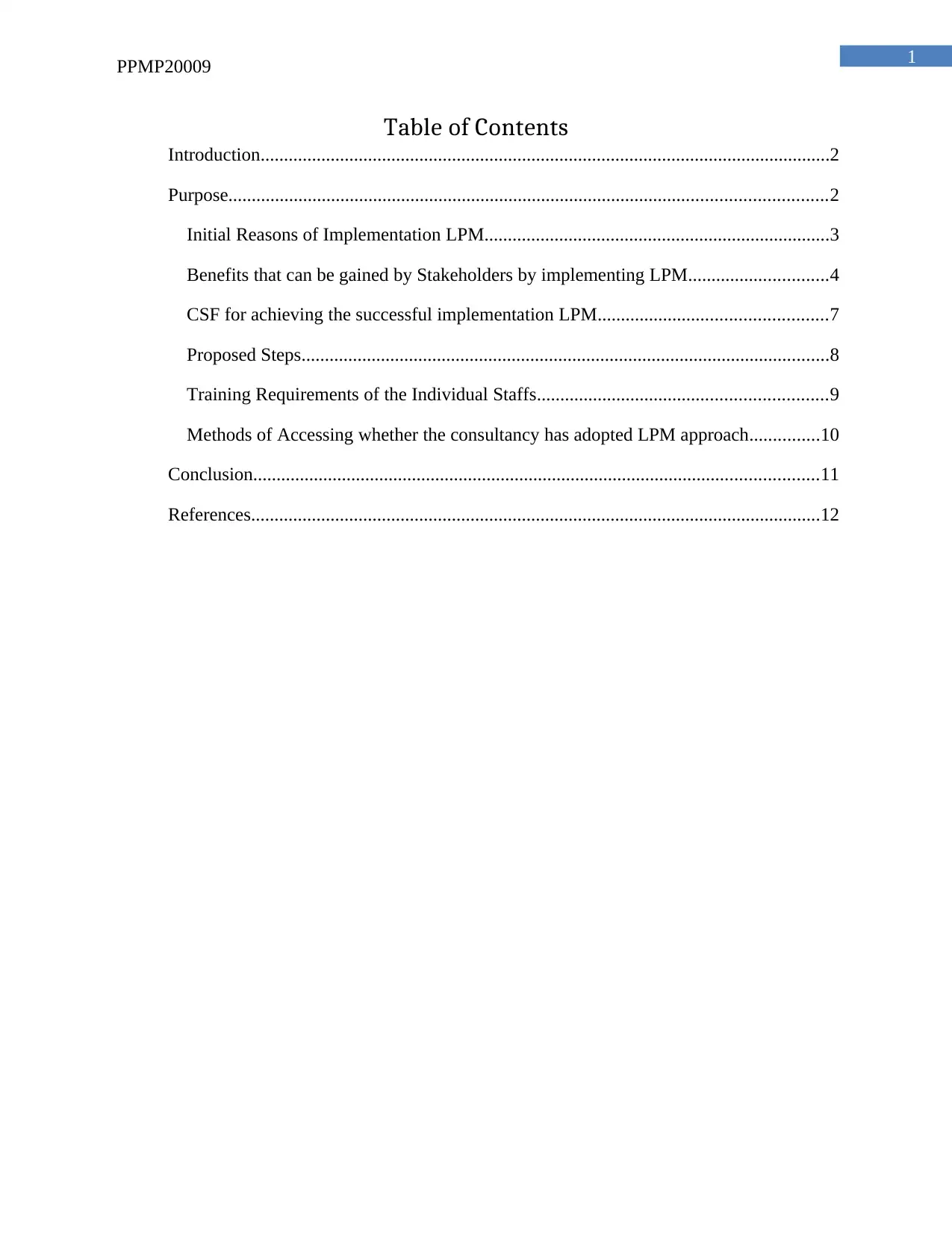
1
PPMP20009
Table of Contents
Introduction..........................................................................................................................2
Purpose................................................................................................................................2
Initial Reasons of Implementation LPM..........................................................................3
Benefits that can be gained by Stakeholders by implementing LPM..............................4
CSF for achieving the successful implementation LPM.................................................7
Proposed Steps.................................................................................................................8
Training Requirements of the Individual Staffs..............................................................9
Methods of Accessing whether the consultancy has adopted LPM approach...............10
Conclusion.........................................................................................................................11
References..........................................................................................................................12
PPMP20009
Table of Contents
Introduction..........................................................................................................................2
Purpose................................................................................................................................2
Initial Reasons of Implementation LPM..........................................................................3
Benefits that can be gained by Stakeholders by implementing LPM..............................4
CSF for achieving the successful implementation LPM.................................................7
Proposed Steps.................................................................................................................8
Training Requirements of the Individual Staffs..............................................................9
Methods of Accessing whether the consultancy has adopted LPM approach...............10
Conclusion.........................................................................................................................11
References..........................................................................................................................12
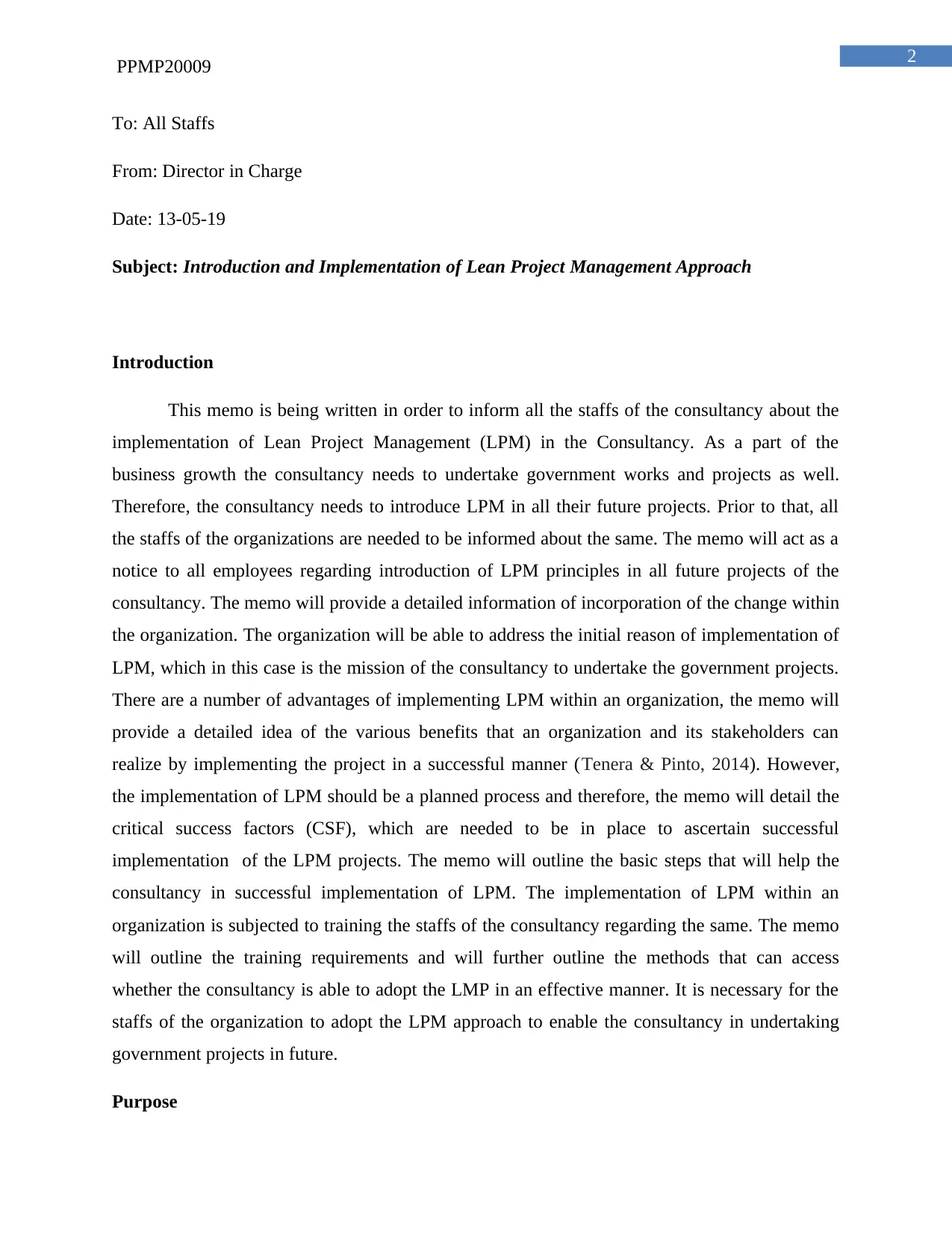
2
PPMP20009
To: All Staffs
From: Director in Charge
Date: 13-05-19
Subject: Introduction and Implementation of Lean Project Management Approach
Introduction
This memo is being written in order to inform all the staffs of the consultancy about the
implementation of Lean Project Management (LPM) in the Consultancy. As a part of the
business growth the consultancy needs to undertake government works and projects as well.
Therefore, the consultancy needs to introduce LPM in all their future projects. Prior to that, all
the staffs of the organizations are needed to be informed about the same. The memo will act as a
notice to all employees regarding introduction of LPM principles in all future projects of the
consultancy. The memo will provide a detailed information of incorporation of the change within
the organization. The organization will be able to address the initial reason of implementation of
LPM, which in this case is the mission of the consultancy to undertake the government projects.
There are a number of advantages of implementing LPM within an organization, the memo will
provide a detailed idea of the various benefits that an organization and its stakeholders can
realize by implementing the project in a successful manner (Tenera & Pinto, 2014). However,
the implementation of LPM should be a planned process and therefore, the memo will detail the
critical success factors (CSF), which are needed to be in place to ascertain successful
implementation of the LPM projects. The memo will outline the basic steps that will help the
consultancy in successful implementation of LPM. The implementation of LPM within an
organization is subjected to training the staffs of the consultancy regarding the same. The memo
will outline the training requirements and will further outline the methods that can access
whether the consultancy is able to adopt the LMP in an effective manner. It is necessary for the
staffs of the organization to adopt the LPM approach to enable the consultancy in undertaking
government projects in future.
Purpose
PPMP20009
To: All Staffs
From: Director in Charge
Date: 13-05-19
Subject: Introduction and Implementation of Lean Project Management Approach
Introduction
This memo is being written in order to inform all the staffs of the consultancy about the
implementation of Lean Project Management (LPM) in the Consultancy. As a part of the
business growth the consultancy needs to undertake government works and projects as well.
Therefore, the consultancy needs to introduce LPM in all their future projects. Prior to that, all
the staffs of the organizations are needed to be informed about the same. The memo will act as a
notice to all employees regarding introduction of LPM principles in all future projects of the
consultancy. The memo will provide a detailed information of incorporation of the change within
the organization. The organization will be able to address the initial reason of implementation of
LPM, which in this case is the mission of the consultancy to undertake the government projects.
There are a number of advantages of implementing LPM within an organization, the memo will
provide a detailed idea of the various benefits that an organization and its stakeholders can
realize by implementing the project in a successful manner (Tenera & Pinto, 2014). However,
the implementation of LPM should be a planned process and therefore, the memo will detail the
critical success factors (CSF), which are needed to be in place to ascertain successful
implementation of the LPM projects. The memo will outline the basic steps that will help the
consultancy in successful implementation of LPM. The implementation of LPM within an
organization is subjected to training the staffs of the consultancy regarding the same. The memo
will outline the training requirements and will further outline the methods that can access
whether the consultancy is able to adopt the LMP in an effective manner. It is necessary for the
staffs of the organization to adopt the LPM approach to enable the consultancy in undertaking
government projects in future.
Purpose
⊘ This is a preview!⊘
Do you want full access?
Subscribe today to unlock all pages.

Trusted by 1+ million students worldwide
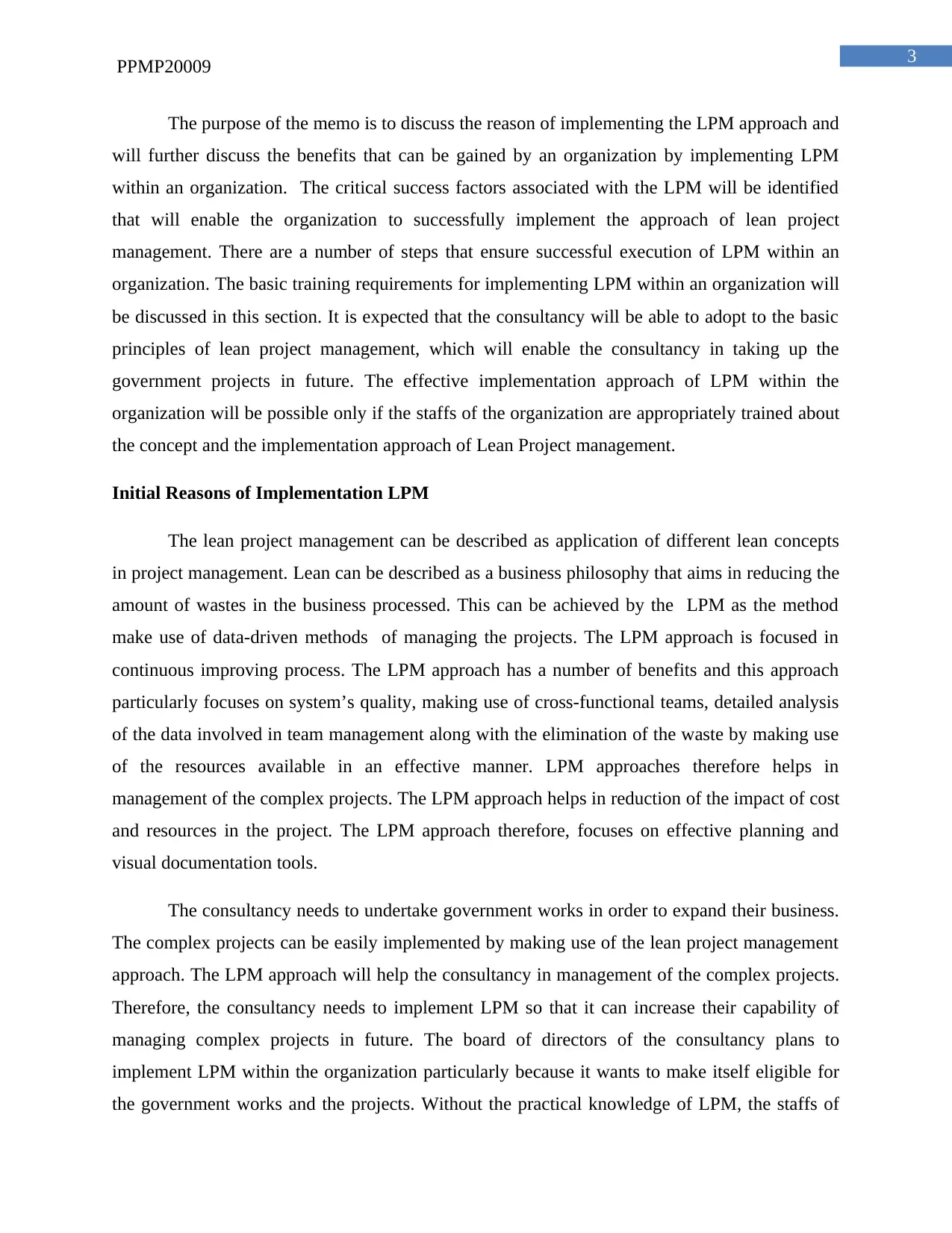
3
PPMP20009
The purpose of the memo is to discuss the reason of implementing the LPM approach and
will further discuss the benefits that can be gained by an organization by implementing LPM
within an organization. The critical success factors associated with the LPM will be identified
that will enable the organization to successfully implement the approach of lean project
management. There are a number of steps that ensure successful execution of LPM within an
organization. The basic training requirements for implementing LPM within an organization will
be discussed in this section. It is expected that the consultancy will be able to adopt to the basic
principles of lean project management, which will enable the consultancy in taking up the
government projects in future. The effective implementation approach of LPM within the
organization will be possible only if the staffs of the organization are appropriately trained about
the concept and the implementation approach of Lean Project management.
Initial Reasons of Implementation LPM
The lean project management can be described as application of different lean concepts
in project management. Lean can be described as a business philosophy that aims in reducing the
amount of wastes in the business processed. This can be achieved by the LPM as the method
make use of data-driven methods of managing the projects. The LPM approach is focused in
continuous improving process. The LPM approach has a number of benefits and this approach
particularly focuses on system’s quality, making use of cross-functional teams, detailed analysis
of the data involved in team management along with the elimination of the waste by making use
of the resources available in an effective manner. LPM approaches therefore helps in
management of the complex projects. The LPM approach helps in reduction of the impact of cost
and resources in the project. The LPM approach therefore, focuses on effective planning and
visual documentation tools.
The consultancy needs to undertake government works in order to expand their business.
The complex projects can be easily implemented by making use of the lean project management
approach. The LPM approach will help the consultancy in management of the complex projects.
Therefore, the consultancy needs to implement LPM so that it can increase their capability of
managing complex projects in future. The board of directors of the consultancy plans to
implement LPM within the organization particularly because it wants to make itself eligible for
the government works and the projects. Without the practical knowledge of LPM, the staffs of
PPMP20009
The purpose of the memo is to discuss the reason of implementing the LPM approach and
will further discuss the benefits that can be gained by an organization by implementing LPM
within an organization. The critical success factors associated with the LPM will be identified
that will enable the organization to successfully implement the approach of lean project
management. There are a number of steps that ensure successful execution of LPM within an
organization. The basic training requirements for implementing LPM within an organization will
be discussed in this section. It is expected that the consultancy will be able to adopt to the basic
principles of lean project management, which will enable the consultancy in taking up the
government projects in future. The effective implementation approach of LPM within the
organization will be possible only if the staffs of the organization are appropriately trained about
the concept and the implementation approach of Lean Project management.
Initial Reasons of Implementation LPM
The lean project management can be described as application of different lean concepts
in project management. Lean can be described as a business philosophy that aims in reducing the
amount of wastes in the business processed. This can be achieved by the LPM as the method
make use of data-driven methods of managing the projects. The LPM approach is focused in
continuous improving process. The LPM approach has a number of benefits and this approach
particularly focuses on system’s quality, making use of cross-functional teams, detailed analysis
of the data involved in team management along with the elimination of the waste by making use
of the resources available in an effective manner. LPM approaches therefore helps in
management of the complex projects. The LPM approach helps in reduction of the impact of cost
and resources in the project. The LPM approach therefore, focuses on effective planning and
visual documentation tools.
The consultancy needs to undertake government works in order to expand their business.
The complex projects can be easily implemented by making use of the lean project management
approach. The LPM approach will help the consultancy in management of the complex projects.
Therefore, the consultancy needs to implement LPM so that it can increase their capability of
managing complex projects in future. The board of directors of the consultancy plans to
implement LPM within the organization particularly because it wants to make itself eligible for
the government works and the projects. Without the practical knowledge of LPM, the staffs of
Paraphrase This Document
Need a fresh take? Get an instant paraphrase of this document with our AI Paraphraser
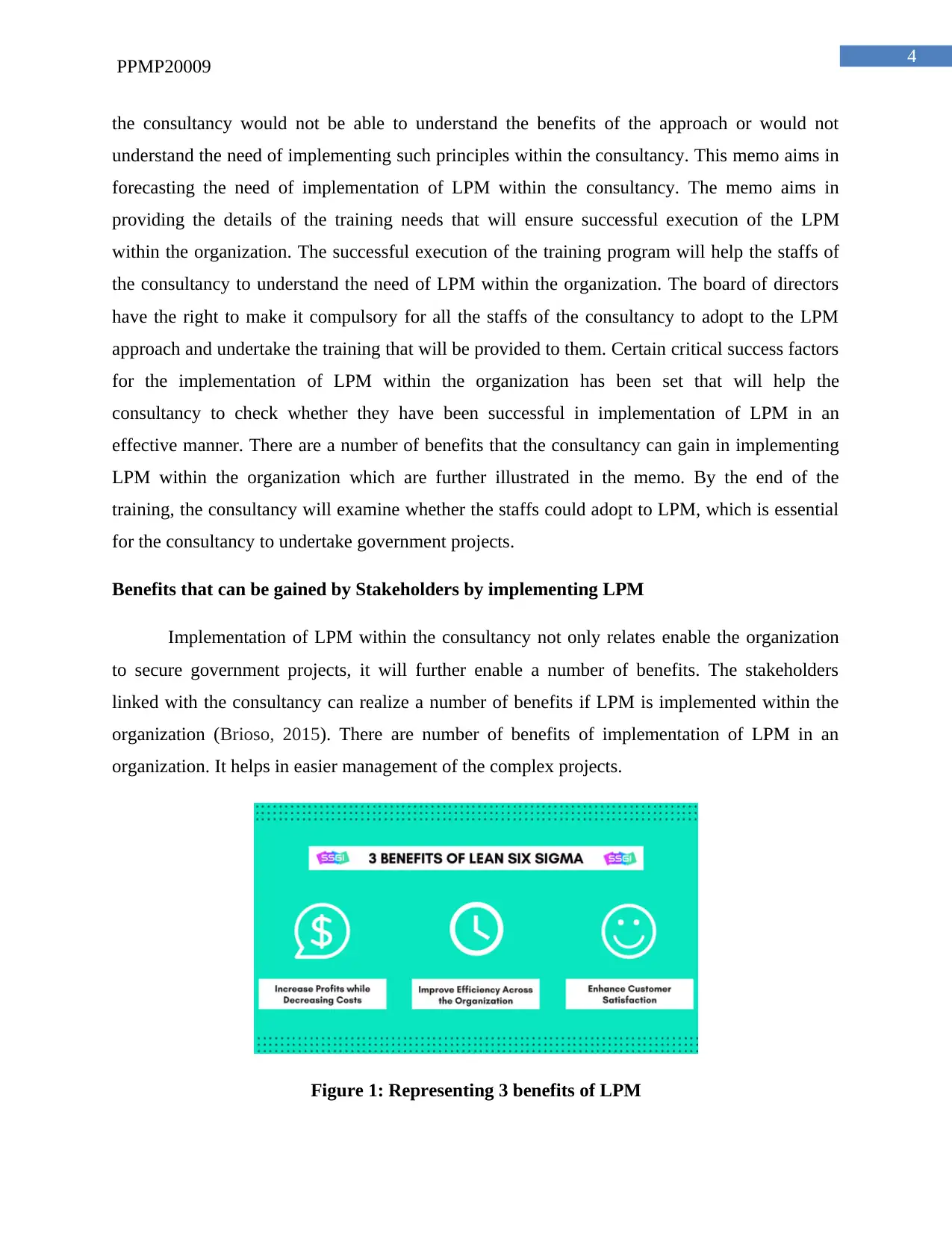
4
PPMP20009
the consultancy would not be able to understand the benefits of the approach or would not
understand the need of implementing such principles within the consultancy. This memo aims in
forecasting the need of implementation of LPM within the consultancy. The memo aims in
providing the details of the training needs that will ensure successful execution of the LPM
within the organization. The successful execution of the training program will help the staffs of
the consultancy to understand the need of LPM within the organization. The board of directors
have the right to make it compulsory for all the staffs of the consultancy to adopt to the LPM
approach and undertake the training that will be provided to them. Certain critical success factors
for the implementation of LPM within the organization has been set that will help the
consultancy to check whether they have been successful in implementation of LPM in an
effective manner. There are a number of benefits that the consultancy can gain in implementing
LPM within the organization which are further illustrated in the memo. By the end of the
training, the consultancy will examine whether the staffs could adopt to LPM, which is essential
for the consultancy to undertake government projects.
Benefits that can be gained by Stakeholders by implementing LPM
Implementation of LPM within the consultancy not only relates enable the organization
to secure government projects, it will further enable a number of benefits. The stakeholders
linked with the consultancy can realize a number of benefits if LPM is implemented within the
organization (Brioso, 2015). There are number of benefits of implementation of LPM in an
organization. It helps in easier management of the complex projects.
Figure 1: Representing 3 benefits of LPM
PPMP20009
the consultancy would not be able to understand the benefits of the approach or would not
understand the need of implementing such principles within the consultancy. This memo aims in
forecasting the need of implementation of LPM within the consultancy. The memo aims in
providing the details of the training needs that will ensure successful execution of the LPM
within the organization. The successful execution of the training program will help the staffs of
the consultancy to understand the need of LPM within the organization. The board of directors
have the right to make it compulsory for all the staffs of the consultancy to adopt to the LPM
approach and undertake the training that will be provided to them. Certain critical success factors
for the implementation of LPM within the organization has been set that will help the
consultancy to check whether they have been successful in implementation of LPM in an
effective manner. There are a number of benefits that the consultancy can gain in implementing
LPM within the organization which are further illustrated in the memo. By the end of the
training, the consultancy will examine whether the staffs could adopt to LPM, which is essential
for the consultancy to undertake government projects.
Benefits that can be gained by Stakeholders by implementing LPM
Implementation of LPM within the consultancy not only relates enable the organization
to secure government projects, it will further enable a number of benefits. The stakeholders
linked with the consultancy can realize a number of benefits if LPM is implemented within the
organization (Brioso, 2015). There are number of benefits of implementation of LPM in an
organization. It helps in easier management of the complex projects.
Figure 1: Representing 3 benefits of LPM
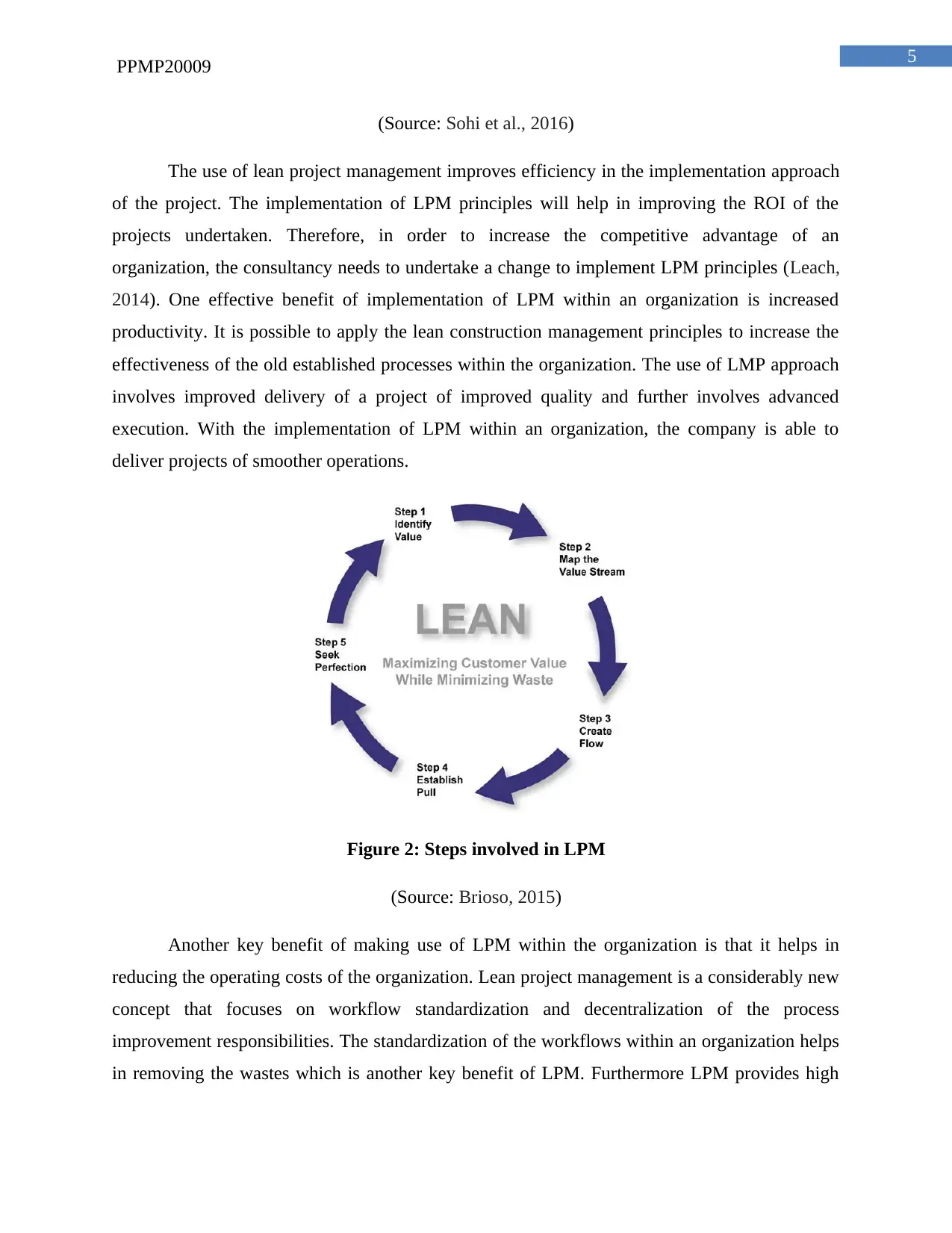
5
PPMP20009
(Source: Sohi et al., 2016)
The use of lean project management improves efficiency in the implementation approach
of the project. The implementation of LPM principles will help in improving the ROI of the
projects undertaken. Therefore, in order to increase the competitive advantage of an
organization, the consultancy needs to undertake a change to implement LPM principles (Leach,
2014). One effective benefit of implementation of LPM within an organization is increased
productivity. It is possible to apply the lean construction management principles to increase the
effectiveness of the old established processes within the organization. The use of LMP approach
involves improved delivery of a project of improved quality and further involves advanced
execution. With the implementation of LPM within an organization, the company is able to
deliver projects of smoother operations.
Figure 2: Steps involved in LPM
(Source: Brioso, 2015)
Another key benefit of making use of LPM within the organization is that it helps in
reducing the operating costs of the organization. Lean project management is a considerably new
concept that focuses on workflow standardization and decentralization of the process
improvement responsibilities. The standardization of the workflows within an organization helps
in removing the wastes which is another key benefit of LPM. Furthermore LPM provides high
PPMP20009
(Source: Sohi et al., 2016)
The use of lean project management improves efficiency in the implementation approach
of the project. The implementation of LPM principles will help in improving the ROI of the
projects undertaken. Therefore, in order to increase the competitive advantage of an
organization, the consultancy needs to undertake a change to implement LPM principles (Leach,
2014). One effective benefit of implementation of LPM within an organization is increased
productivity. It is possible to apply the lean construction management principles to increase the
effectiveness of the old established processes within the organization. The use of LMP approach
involves improved delivery of a project of improved quality and further involves advanced
execution. With the implementation of LPM within an organization, the company is able to
deliver projects of smoother operations.
Figure 2: Steps involved in LPM
(Source: Brioso, 2015)
Another key benefit of making use of LPM within the organization is that it helps in
reducing the operating costs of the organization. Lean project management is a considerably new
concept that focuses on workflow standardization and decentralization of the process
improvement responsibilities. The standardization of the workflows within an organization helps
in removing the wastes which is another key benefit of LPM. Furthermore LPM provides high
⊘ This is a preview!⊘
Do you want full access?
Subscribe today to unlock all pages.

Trusted by 1+ million students worldwide
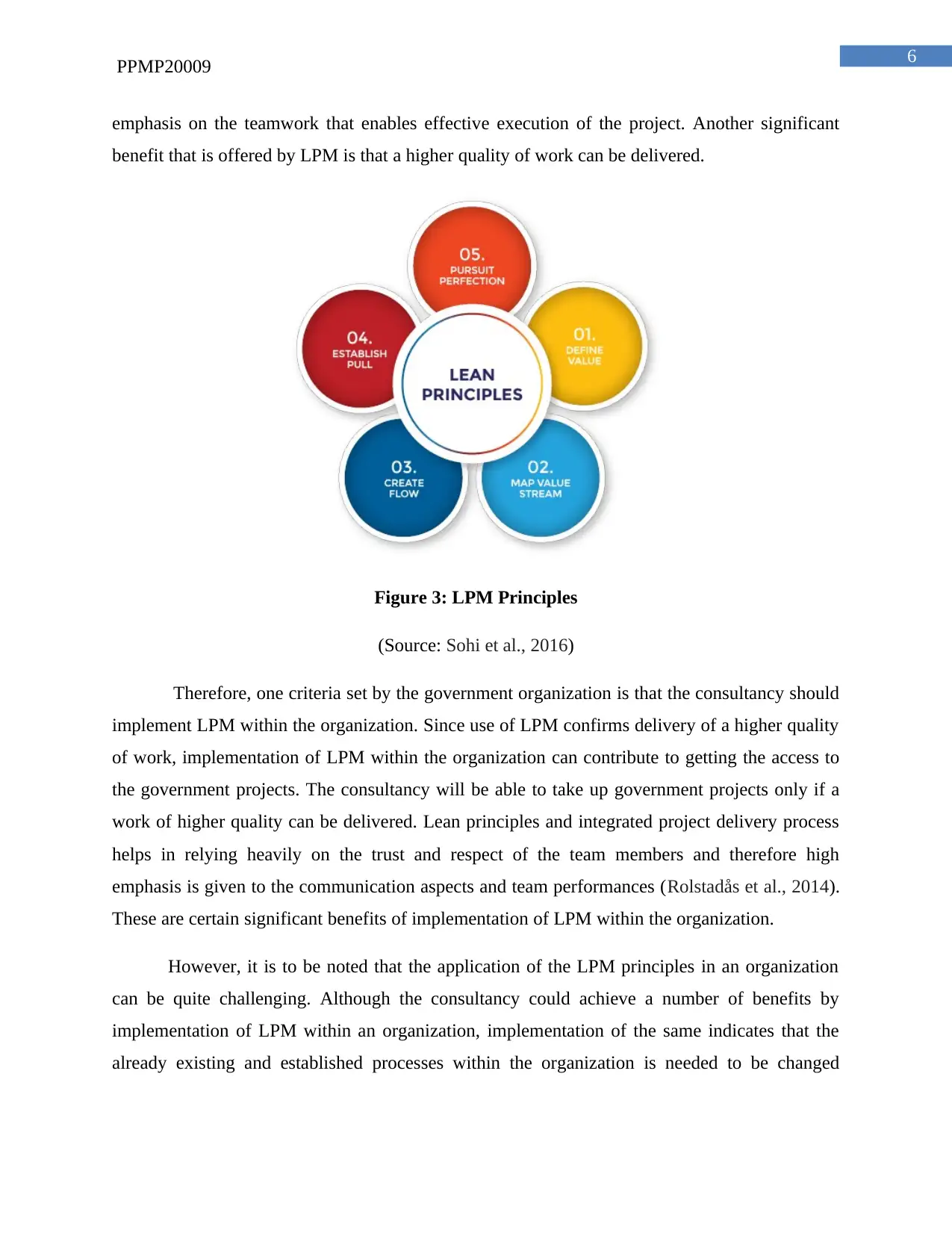
6
PPMP20009
emphasis on the teamwork that enables effective execution of the project. Another significant
benefit that is offered by LPM is that a higher quality of work can be delivered.
Figure 3: LPM Principles
(Source: Sohi et al., 2016)
Therefore, one criteria set by the government organization is that the consultancy should
implement LPM within the organization. Since use of LPM confirms delivery of a higher quality
of work, implementation of LPM within the organization can contribute to getting the access to
the government projects. The consultancy will be able to take up government projects only if a
work of higher quality can be delivered. Lean principles and integrated project delivery process
helps in relying heavily on the trust and respect of the team members and therefore high
emphasis is given to the communication aspects and team performances (Rolstadås et al., 2014).
These are certain significant benefits of implementation of LPM within the organization.
However, it is to be noted that the application of the LPM principles in an organization
can be quite challenging. Although the consultancy could achieve a number of benefits by
implementation of LPM within an organization, implementation of the same indicates that the
already existing and established processes within the organization is needed to be changed
PPMP20009
emphasis on the teamwork that enables effective execution of the project. Another significant
benefit that is offered by LPM is that a higher quality of work can be delivered.
Figure 3: LPM Principles
(Source: Sohi et al., 2016)
Therefore, one criteria set by the government organization is that the consultancy should
implement LPM within the organization. Since use of LPM confirms delivery of a higher quality
of work, implementation of LPM within the organization can contribute to getting the access to
the government projects. The consultancy will be able to take up government projects only if a
work of higher quality can be delivered. Lean principles and integrated project delivery process
helps in relying heavily on the trust and respect of the team members and therefore high
emphasis is given to the communication aspects and team performances (Rolstadås et al., 2014).
These are certain significant benefits of implementation of LPM within the organization.
However, it is to be noted that the application of the LPM principles in an organization
can be quite challenging. Although the consultancy could achieve a number of benefits by
implementation of LPM within an organization, implementation of the same indicates that the
already existing and established processes within the organization is needed to be changed
Paraphrase This Document
Need a fresh take? Get an instant paraphrase of this document with our AI Paraphraser
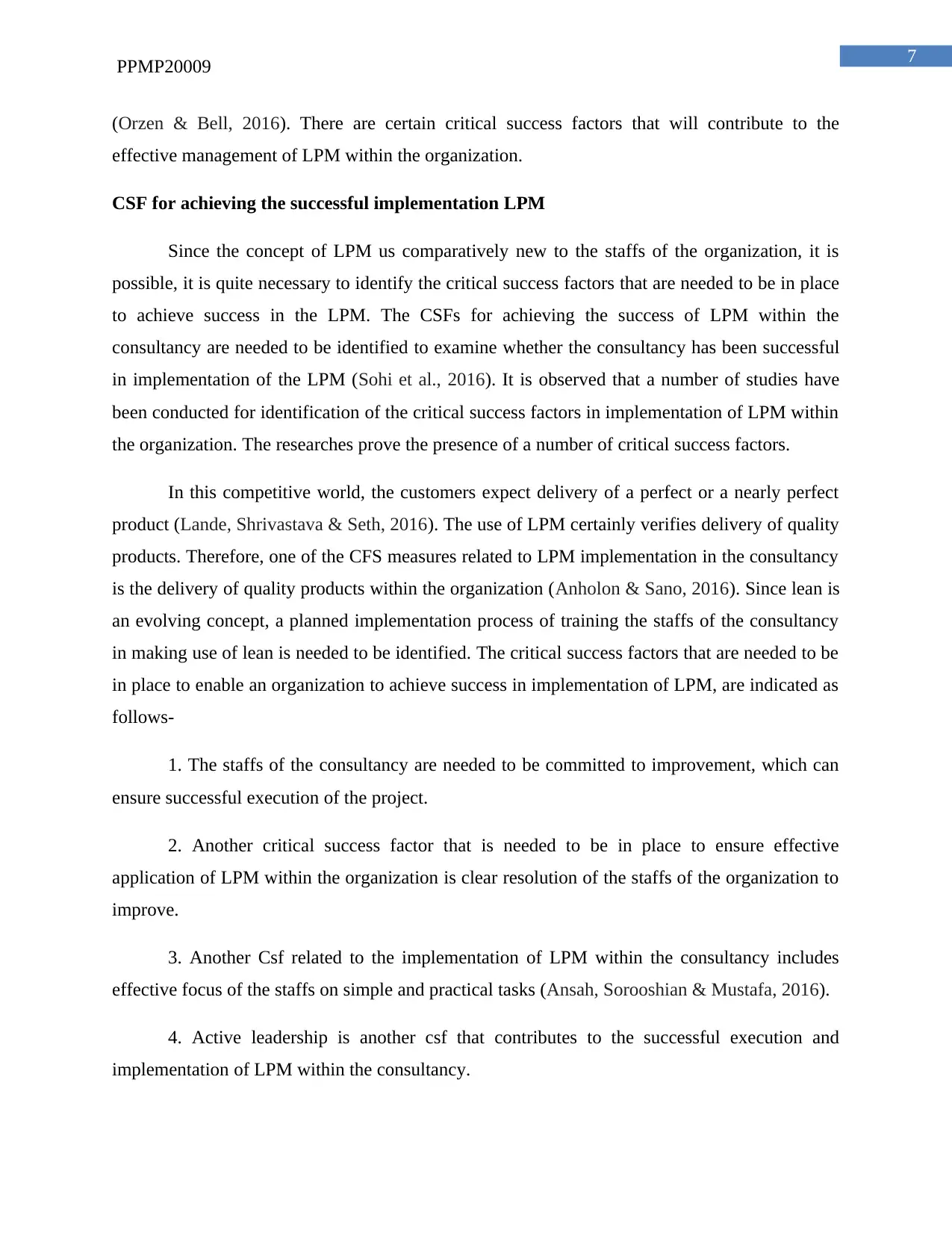
7
PPMP20009
(Orzen & Bell, 2016). There are certain critical success factors that will contribute to the
effective management of LPM within the organization.
CSF for achieving the successful implementation LPM
Since the concept of LPM us comparatively new to the staffs of the organization, it is
possible, it is quite necessary to identify the critical success factors that are needed to be in place
to achieve success in the LPM. The CSFs for achieving the success of LPM within the
consultancy are needed to be identified to examine whether the consultancy has been successful
in implementation of the LPM (Sohi et al., 2016). It is observed that a number of studies have
been conducted for identification of the critical success factors in implementation of LPM within
the organization. The researches prove the presence of a number of critical success factors.
In this competitive world, the customers expect delivery of a perfect or a nearly perfect
product (Lande, Shrivastava & Seth, 2016). The use of LPM certainly verifies delivery of quality
products. Therefore, one of the CFS measures related to LPM implementation in the consultancy
is the delivery of quality products within the organization (Anholon & Sano, 2016). Since lean is
an evolving concept, a planned implementation process of training the staffs of the consultancy
in making use of lean is needed to be identified. The critical success factors that are needed to be
in place to enable an organization to achieve success in implementation of LPM, are indicated as
follows-
1. The staffs of the consultancy are needed to be committed to improvement, which can
ensure successful execution of the project.
2. Another critical success factor that is needed to be in place to ensure effective
application of LPM within the organization is clear resolution of the staffs of the organization to
improve.
3. Another Csf related to the implementation of LPM within the consultancy includes
effective focus of the staffs on simple and practical tasks (Ansah, Sorooshian & Mustafa, 2016).
4. Active leadership is another csf that contributes to the successful execution and
implementation of LPM within the consultancy.
PPMP20009
(Orzen & Bell, 2016). There are certain critical success factors that will contribute to the
effective management of LPM within the organization.
CSF for achieving the successful implementation LPM
Since the concept of LPM us comparatively new to the staffs of the organization, it is
possible, it is quite necessary to identify the critical success factors that are needed to be in place
to achieve success in the LPM. The CSFs for achieving the success of LPM within the
consultancy are needed to be identified to examine whether the consultancy has been successful
in implementation of the LPM (Sohi et al., 2016). It is observed that a number of studies have
been conducted for identification of the critical success factors in implementation of LPM within
the organization. The researches prove the presence of a number of critical success factors.
In this competitive world, the customers expect delivery of a perfect or a nearly perfect
product (Lande, Shrivastava & Seth, 2016). The use of LPM certainly verifies delivery of quality
products. Therefore, one of the CFS measures related to LPM implementation in the consultancy
is the delivery of quality products within the organization (Anholon & Sano, 2016). Since lean is
an evolving concept, a planned implementation process of training the staffs of the consultancy
in making use of lean is needed to be identified. The critical success factors that are needed to be
in place to enable an organization to achieve success in implementation of LPM, are indicated as
follows-
1. The staffs of the consultancy are needed to be committed to improvement, which can
ensure successful execution of the project.
2. Another critical success factor that is needed to be in place to ensure effective
application of LPM within the organization is clear resolution of the staffs of the organization to
improve.
3. Another Csf related to the implementation of LPM within the consultancy includes
effective focus of the staffs on simple and practical tasks (Ansah, Sorooshian & Mustafa, 2016).
4. Active leadership is another csf that contributes to the successful execution and
implementation of LPM within the consultancy.
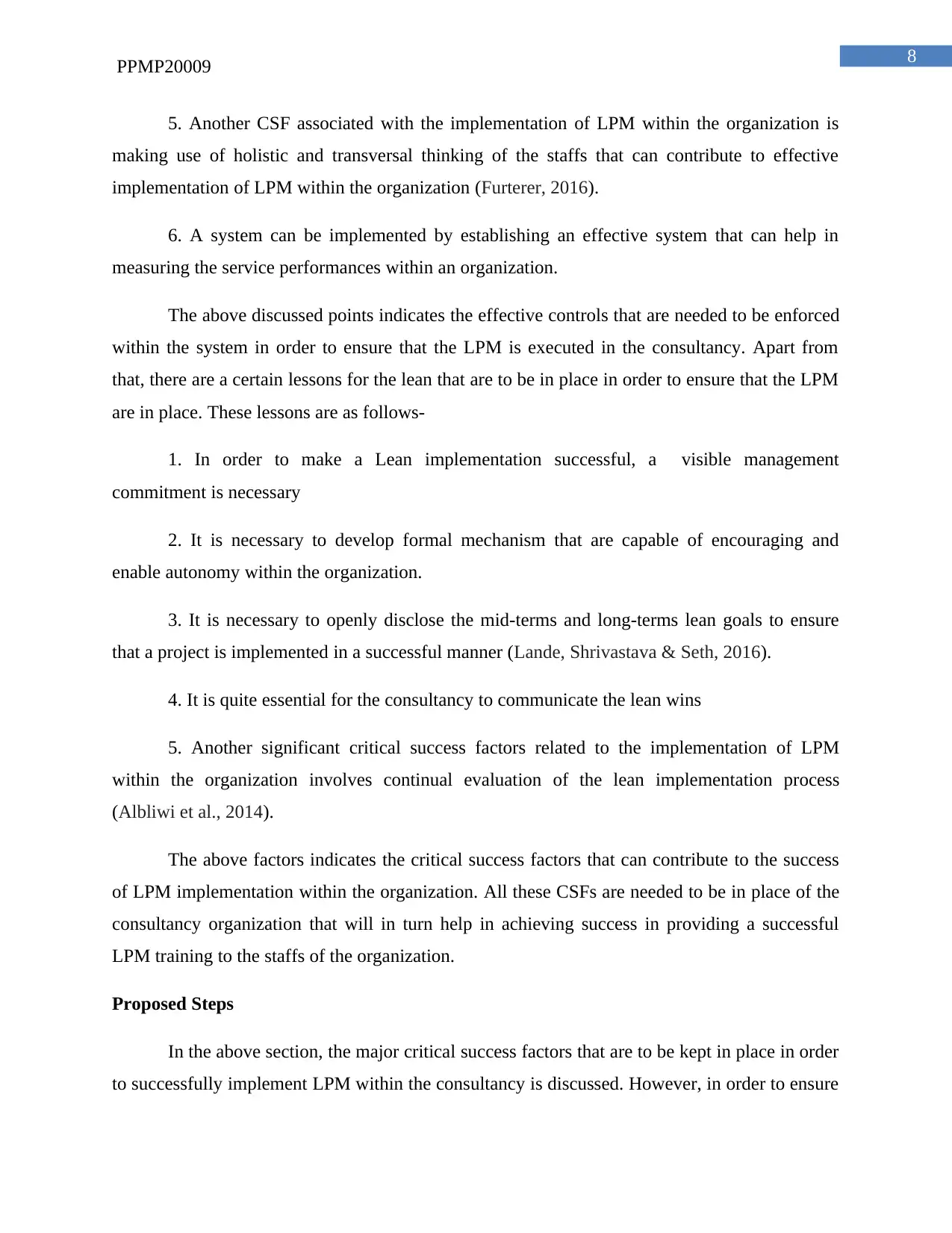
8
PPMP20009
5. Another CSF associated with the implementation of LPM within the organization is
making use of holistic and transversal thinking of the staffs that can contribute to effective
implementation of LPM within the organization (Furterer, 2016).
6. A system can be implemented by establishing an effective system that can help in
measuring the service performances within an organization.
The above discussed points indicates the effective controls that are needed to be enforced
within the system in order to ensure that the LPM is executed in the consultancy. Apart from
that, there are a certain lessons for the lean that are to be in place in order to ensure that the LPM
are in place. These lessons are as follows-
1. In order to make a Lean implementation successful, a visible management
commitment is necessary
2. It is necessary to develop formal mechanism that are capable of encouraging and
enable autonomy within the organization.
3. It is necessary to openly disclose the mid-terms and long-terms lean goals to ensure
that a project is implemented in a successful manner (Lande, Shrivastava & Seth, 2016).
4. It is quite essential for the consultancy to communicate the lean wins
5. Another significant critical success factors related to the implementation of LPM
within the organization involves continual evaluation of the lean implementation process
(Albliwi et al., 2014).
The above factors indicates the critical success factors that can contribute to the success
of LPM implementation within the organization. All these CSFs are needed to be in place of the
consultancy organization that will in turn help in achieving success in providing a successful
LPM training to the staffs of the organization.
Proposed Steps
In the above section, the major critical success factors that are to be kept in place in order
to successfully implement LPM within the consultancy is discussed. However, in order to ensure
PPMP20009
5. Another CSF associated with the implementation of LPM within the organization is
making use of holistic and transversal thinking of the staffs that can contribute to effective
implementation of LPM within the organization (Furterer, 2016).
6. A system can be implemented by establishing an effective system that can help in
measuring the service performances within an organization.
The above discussed points indicates the effective controls that are needed to be enforced
within the system in order to ensure that the LPM is executed in the consultancy. Apart from
that, there are a certain lessons for the lean that are to be in place in order to ensure that the LPM
are in place. These lessons are as follows-
1. In order to make a Lean implementation successful, a visible management
commitment is necessary
2. It is necessary to develop formal mechanism that are capable of encouraging and
enable autonomy within the organization.
3. It is necessary to openly disclose the mid-terms and long-terms lean goals to ensure
that a project is implemented in a successful manner (Lande, Shrivastava & Seth, 2016).
4. It is quite essential for the consultancy to communicate the lean wins
5. Another significant critical success factors related to the implementation of LPM
within the organization involves continual evaluation of the lean implementation process
(Albliwi et al., 2014).
The above factors indicates the critical success factors that can contribute to the success
of LPM implementation within the organization. All these CSFs are needed to be in place of the
consultancy organization that will in turn help in achieving success in providing a successful
LPM training to the staffs of the organization.
Proposed Steps
In the above section, the major critical success factors that are to be kept in place in order
to successfully implement LPM within the consultancy is discussed. However, in order to ensure
⊘ This is a preview!⊘
Do you want full access?
Subscribe today to unlock all pages.

Trusted by 1+ million students worldwide
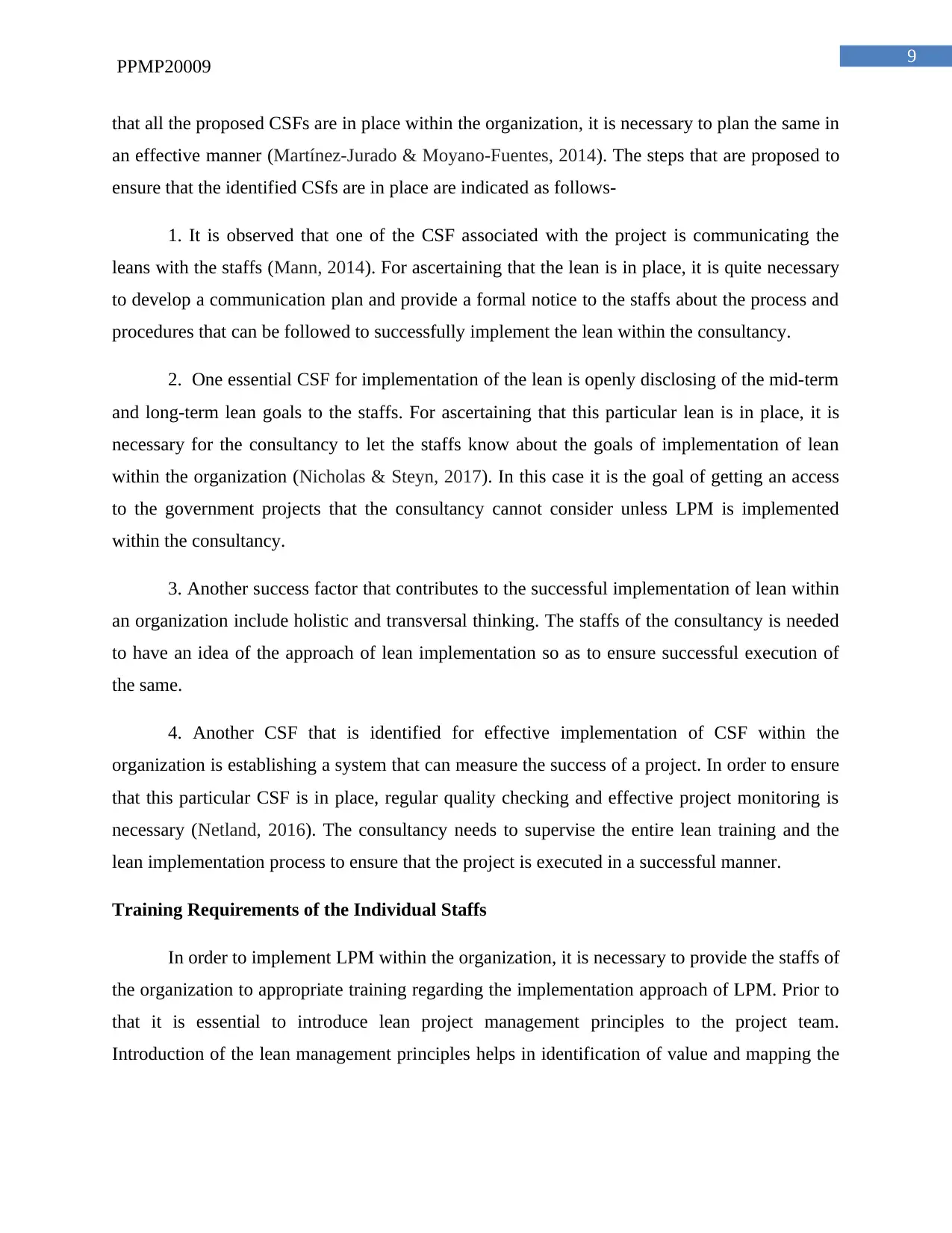
9
PPMP20009
that all the proposed CSFs are in place within the organization, it is necessary to plan the same in
an effective manner (Martínez-Jurado & Moyano-Fuentes, 2014). The steps that are proposed to
ensure that the identified CSfs are in place are indicated as follows-
1. It is observed that one of the CSF associated with the project is communicating the
leans with the staffs (Mann, 2014). For ascertaining that the lean is in place, it is quite necessary
to develop a communication plan and provide a formal notice to the staffs about the process and
procedures that can be followed to successfully implement the lean within the consultancy.
2. One essential CSF for implementation of the lean is openly disclosing of the mid-term
and long-term lean goals to the staffs. For ascertaining that this particular lean is in place, it is
necessary for the consultancy to let the staffs know about the goals of implementation of lean
within the organization (Nicholas & Steyn, 2017). In this case it is the goal of getting an access
to the government projects that the consultancy cannot consider unless LPM is implemented
within the consultancy.
3. Another success factor that contributes to the successful implementation of lean within
an organization include holistic and transversal thinking. The staffs of the consultancy is needed
to have an idea of the approach of lean implementation so as to ensure successful execution of
the same.
4. Another CSF that is identified for effective implementation of CSF within the
organization is establishing a system that can measure the success of a project. In order to ensure
that this particular CSF is in place, regular quality checking and effective project monitoring is
necessary (Netland, 2016). The consultancy needs to supervise the entire lean training and the
lean implementation process to ensure that the project is executed in a successful manner.
Training Requirements of the Individual Staffs
In order to implement LPM within the organization, it is necessary to provide the staffs of
the organization to appropriate training regarding the implementation approach of LPM. Prior to
that it is essential to introduce lean project management principles to the project team.
Introduction of the lean management principles helps in identification of value and mapping the
PPMP20009
that all the proposed CSFs are in place within the organization, it is necessary to plan the same in
an effective manner (Martínez-Jurado & Moyano-Fuentes, 2014). The steps that are proposed to
ensure that the identified CSfs are in place are indicated as follows-
1. It is observed that one of the CSF associated with the project is communicating the
leans with the staffs (Mann, 2014). For ascertaining that the lean is in place, it is quite necessary
to develop a communication plan and provide a formal notice to the staffs about the process and
procedures that can be followed to successfully implement the lean within the consultancy.
2. One essential CSF for implementation of the lean is openly disclosing of the mid-term
and long-term lean goals to the staffs. For ascertaining that this particular lean is in place, it is
necessary for the consultancy to let the staffs know about the goals of implementation of lean
within the organization (Nicholas & Steyn, 2017). In this case it is the goal of getting an access
to the government projects that the consultancy cannot consider unless LPM is implemented
within the consultancy.
3. Another success factor that contributes to the successful implementation of lean within
an organization include holistic and transversal thinking. The staffs of the consultancy is needed
to have an idea of the approach of lean implementation so as to ensure successful execution of
the same.
4. Another CSF that is identified for effective implementation of CSF within the
organization is establishing a system that can measure the success of a project. In order to ensure
that this particular CSF is in place, regular quality checking and effective project monitoring is
necessary (Netland, 2016). The consultancy needs to supervise the entire lean training and the
lean implementation process to ensure that the project is executed in a successful manner.
Training Requirements of the Individual Staffs
In order to implement LPM within the organization, it is necessary to provide the staffs of
the organization to appropriate training regarding the implementation approach of LPM. Prior to
that it is essential to introduce lean project management principles to the project team.
Introduction of the lean management principles helps in identification of value and mapping the
Paraphrase This Document
Need a fresh take? Get an instant paraphrase of this document with our AI Paraphraser
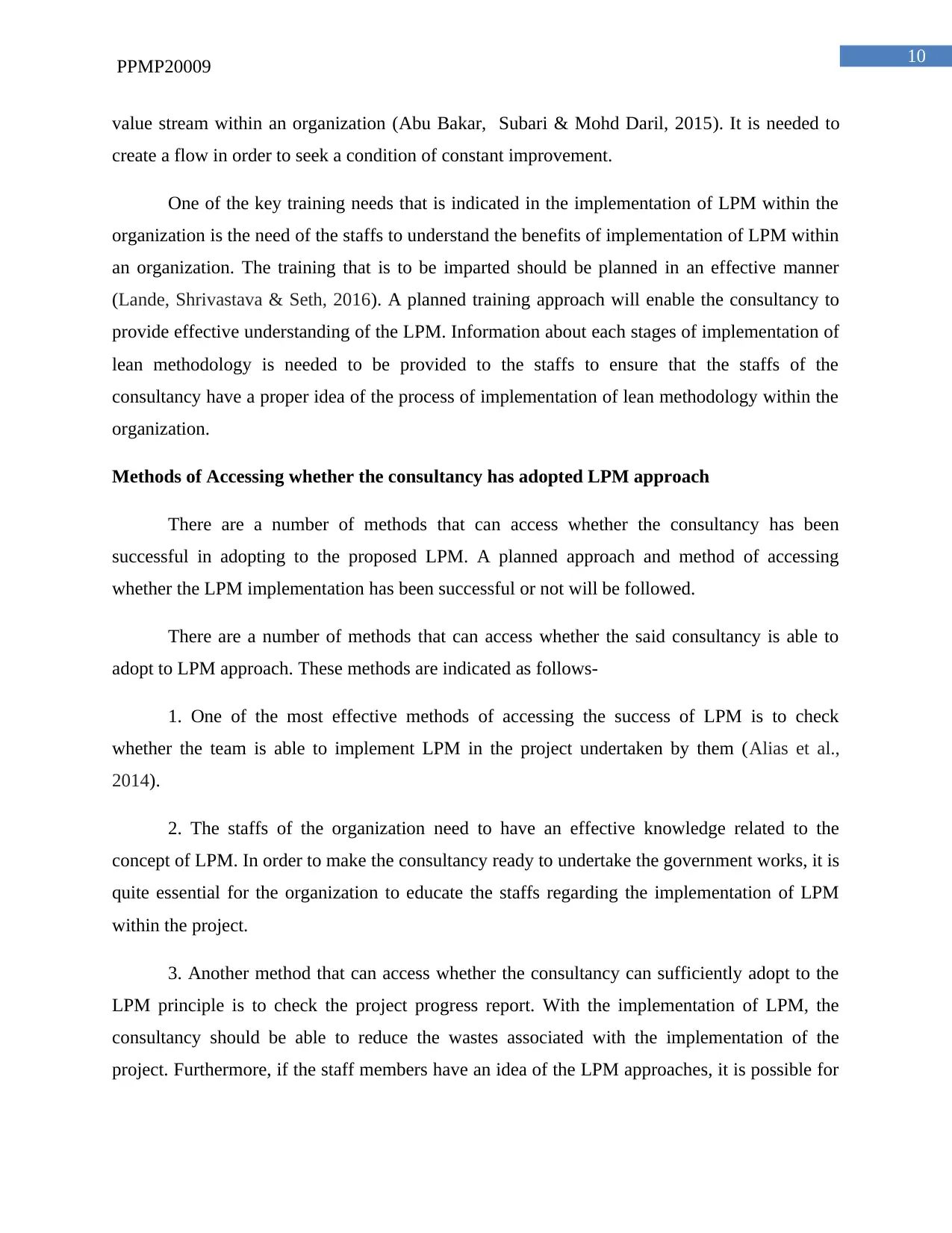
10
PPMP20009
value stream within an organization (Abu Bakar, Subari & Mohd Daril, 2015). It is needed to
create a flow in order to seek a condition of constant improvement.
One of the key training needs that is indicated in the implementation of LPM within the
organization is the need of the staffs to understand the benefits of implementation of LPM within
an organization. The training that is to be imparted should be planned in an effective manner
(Lande, Shrivastava & Seth, 2016). A planned training approach will enable the consultancy to
provide effective understanding of the LPM. Information about each stages of implementation of
lean methodology is needed to be provided to the staffs to ensure that the staffs of the
consultancy have a proper idea of the process of implementation of lean methodology within the
organization.
Methods of Accessing whether the consultancy has adopted LPM approach
There are a number of methods that can access whether the consultancy has been
successful in adopting to the proposed LPM. A planned approach and method of accessing
whether the LPM implementation has been successful or not will be followed.
There are a number of methods that can access whether the said consultancy is able to
adopt to LPM approach. These methods are indicated as follows-
1. One of the most effective methods of accessing the success of LPM is to check
whether the team is able to implement LPM in the project undertaken by them (Alias et al.,
2014).
2. The staffs of the organization need to have an effective knowledge related to the
concept of LPM. In order to make the consultancy ready to undertake the government works, it is
quite essential for the organization to educate the staffs regarding the implementation of LPM
within the project.
3. Another method that can access whether the consultancy can sufficiently adopt to the
LPM principle is to check the project progress report. With the implementation of LPM, the
consultancy should be able to reduce the wastes associated with the implementation of the
project. Furthermore, if the staff members have an idea of the LPM approaches, it is possible for
PPMP20009
value stream within an organization (Abu Bakar, Subari & Mohd Daril, 2015). It is needed to
create a flow in order to seek a condition of constant improvement.
One of the key training needs that is indicated in the implementation of LPM within the
organization is the need of the staffs to understand the benefits of implementation of LPM within
an organization. The training that is to be imparted should be planned in an effective manner
(Lande, Shrivastava & Seth, 2016). A planned training approach will enable the consultancy to
provide effective understanding of the LPM. Information about each stages of implementation of
lean methodology is needed to be provided to the staffs to ensure that the staffs of the
consultancy have a proper idea of the process of implementation of lean methodology within the
organization.
Methods of Accessing whether the consultancy has adopted LPM approach
There are a number of methods that can access whether the consultancy has been
successful in adopting to the proposed LPM. A planned approach and method of accessing
whether the LPM implementation has been successful or not will be followed.
There are a number of methods that can access whether the said consultancy is able to
adopt to LPM approach. These methods are indicated as follows-
1. One of the most effective methods of accessing the success of LPM is to check
whether the team is able to implement LPM in the project undertaken by them (Alias et al.,
2014).
2. The staffs of the organization need to have an effective knowledge related to the
concept of LPM. In order to make the consultancy ready to undertake the government works, it is
quite essential for the organization to educate the staffs regarding the implementation of LPM
within the project.
3. Another method that can access whether the consultancy can sufficiently adopt to the
LPM principle is to check the project progress report. With the implementation of LPM, the
consultancy should be able to reduce the wastes associated with the implementation of the
project. Furthermore, if the staff members have an idea of the LPM approaches, it is possible for
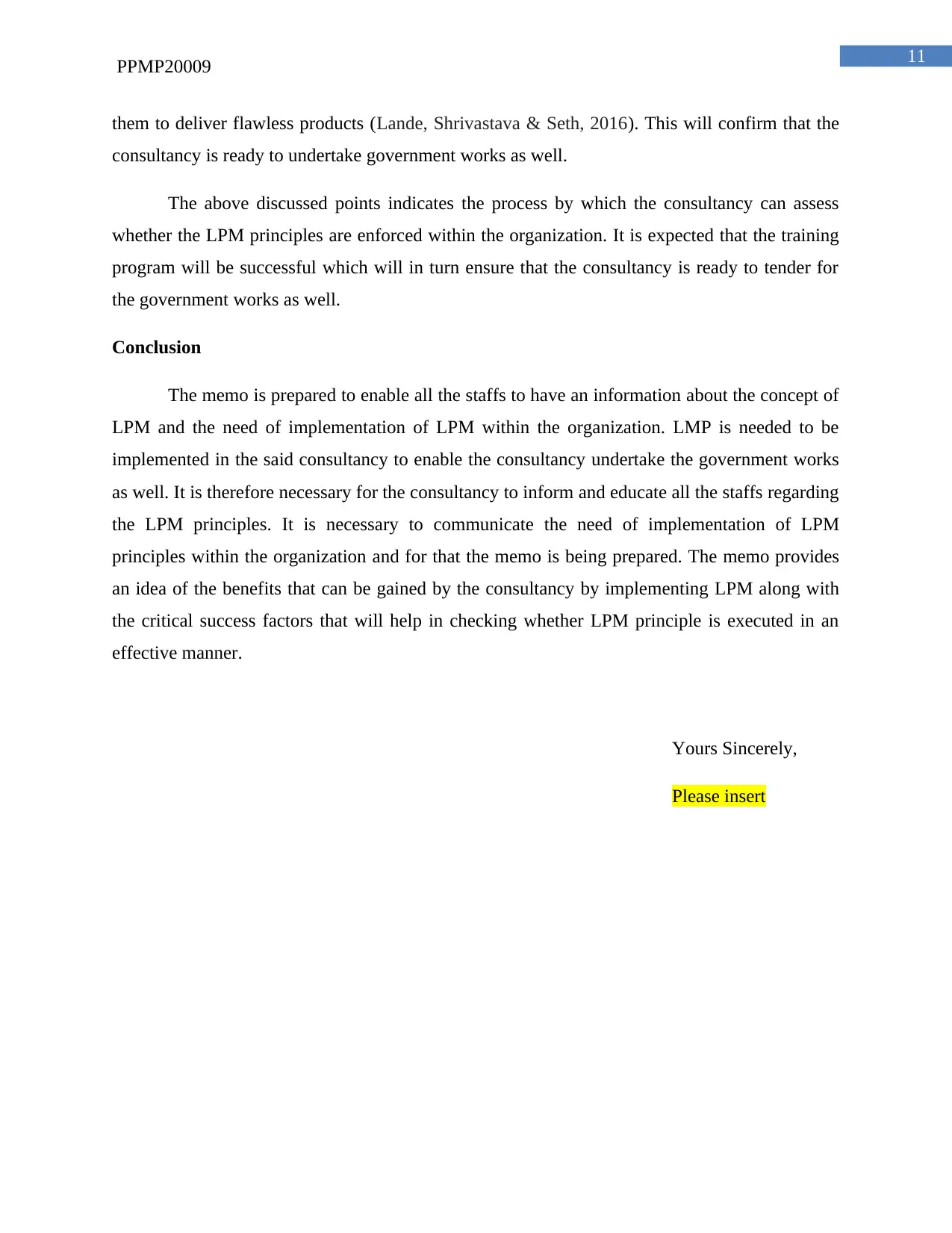
11
PPMP20009
them to deliver flawless products (Lande, Shrivastava & Seth, 2016). This will confirm that the
consultancy is ready to undertake government works as well.
The above discussed points indicates the process by which the consultancy can assess
whether the LPM principles are enforced within the organization. It is expected that the training
program will be successful which will in turn ensure that the consultancy is ready to tender for
the government works as well.
Conclusion
The memo is prepared to enable all the staffs to have an information about the concept of
LPM and the need of implementation of LPM within the organization. LMP is needed to be
implemented in the said consultancy to enable the consultancy undertake the government works
as well. It is therefore necessary for the consultancy to inform and educate all the staffs regarding
the LPM principles. It is necessary to communicate the need of implementation of LPM
principles within the organization and for that the memo is being prepared. The memo provides
an idea of the benefits that can be gained by the consultancy by implementing LPM along with
the critical success factors that will help in checking whether LPM principle is executed in an
effective manner.
Yours Sincerely,
Please insert
PPMP20009
them to deliver flawless products (Lande, Shrivastava & Seth, 2016). This will confirm that the
consultancy is ready to undertake government works as well.
The above discussed points indicates the process by which the consultancy can assess
whether the LPM principles are enforced within the organization. It is expected that the training
program will be successful which will in turn ensure that the consultancy is ready to tender for
the government works as well.
Conclusion
The memo is prepared to enable all the staffs to have an information about the concept of
LPM and the need of implementation of LPM within the organization. LMP is needed to be
implemented in the said consultancy to enable the consultancy undertake the government works
as well. It is therefore necessary for the consultancy to inform and educate all the staffs regarding
the LPM principles. It is necessary to communicate the need of implementation of LPM
principles within the organization and for that the memo is being prepared. The memo provides
an idea of the benefits that can be gained by the consultancy by implementing LPM along with
the critical success factors that will help in checking whether LPM principle is executed in an
effective manner.
Yours Sincerely,
Please insert
⊘ This is a preview!⊘
Do you want full access?
Subscribe today to unlock all pages.

Trusted by 1+ million students worldwide
1 out of 15
Related Documents
Your All-in-One AI-Powered Toolkit for Academic Success.
+13062052269
info@desklib.com
Available 24*7 on WhatsApp / Email
![[object Object]](/_next/static/media/star-bottom.7253800d.svg)
Unlock your academic potential
Copyright © 2020–2025 A2Z Services. All Rights Reserved. Developed and managed by ZUCOL.


